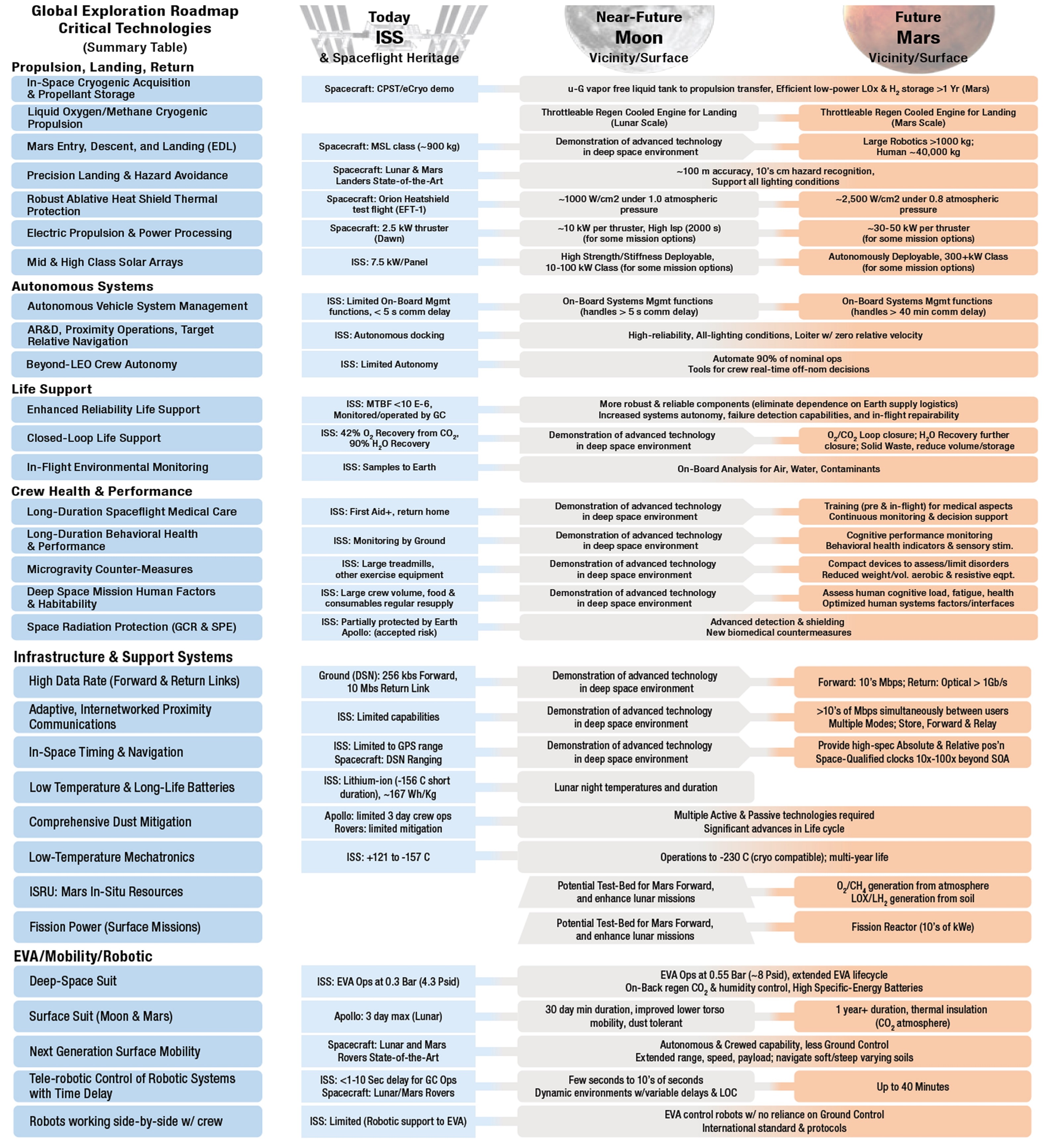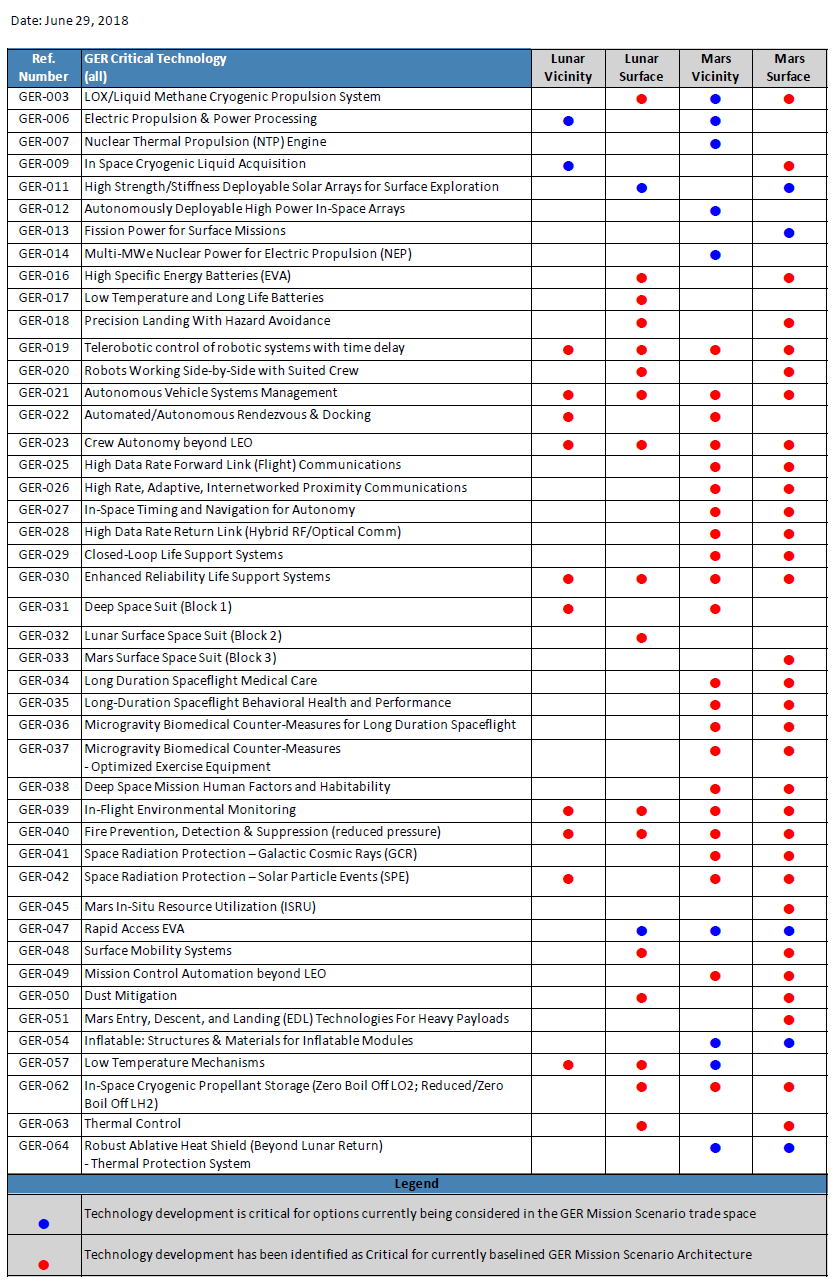While space faring nations have made major technology progress and surmounted great challenges over the last 50 years, several significant technological advances are required to implement the Mission Scenario of the International Space Exploration Coordination Group (ISECG), which is presented in the 2018 release of the Global Exploration Roadmap (GER). As space agencies agree that no single agency has the resources to invest robustly in all of these technologies, appropriately leveraging global investments in technology development and demonstration is expected not only to enable but also to accelerate the availability of critical capabilities. However, technology development is a competitive area and agencies want to identify where they should focus their investments to maximize their contribution potential while ensuring that they play a critical and visible part in the exploration endeavor.
About the ISECG Technology Working Group (TWG)
The Technology Working Group (TWG) is one of the working teams of the ISECG. The principal goal of the TWG is to facilitate leveraging investments in technology development efforts of individual ISECG agencies supporting implementation of the GER. Recognizing the strategic nature of technology investments for agencies, it is also the goal of the Technology Working Group (TWG) to advocate coordination and collaboration in technology development efforts of individual ISECG space agencies in support of the GER mission scenario.
GER Technology Development Mapping
The TWG categorises technology development inputs of participating agencies by technology areas and maps them to the elements and capabilities identified in the GER mission scenario.
The inputs of the participating ISECG space agencies are categorized using the NASA Space Technology Roadmaps Technology Area Breakdown Structure (TABS) and mapped to the elements and capabilities identified in the GER mission scenario. This allows to develop a detailed picture of technology developments across the space exploration community. It allow to combine, in a systematic fashion, technology development entries of several participating ISECG space agencies as well as the analysis from many different angles, providing valuable insights into overlapping areas and investment gaps for both individual agencies and the global ISECG teams. This allows identifying potential challenges for the GER implementation as well as innovative competition or new collaboration opportunities.
The following listings contain public products and papers produced by the TWG. Please note that the TWG is an active working group; and as such, is consistently updating information reflecting individual agency’s technology development data along with the evolution of the GER Critical Technology Portfolio itself. Content will change as further GER architecture details are developed and the associated critical technology analysis is iterated further.
ISECG GER Critical Technologies Portfolio
The following table highlights technologies identified by the ISECG as critical for future exploration missions. The target performance for each technology is based on preliminary analysis for human Moon and Mars missions, and may change as the analysis is iterated further. There are technologies where the state of the art is sufficient for near-term lunar operations and opportunities exist to demonstrate advancements needed for Mars.
Download the Global Exploration Roadmap v.3 for further information.
GER Critical Technologies Portfolio Summary
The following table provides a summary list of the GER Critical Technologies and their relevance for specific exploration destinations.
GER Critical Technologies Report
The International Space Exploration Coordination Group (ISECG) participating space agencies have identified a list of critical technologies related to the missions shown in the Global Exploration Roadmap (GER) that are currently not available or which need to be developed or matured.
The current list of technologies has been identified as being critical to advance the ISECG mission scenarios. It is building on a portfolio list of enabling critical technologies resulting from a human deep space exploration architecture analysis conducted by NASA and published in 2012.
Global Exploration Roadmap Critical Technology Needs
[Issue date: 13 December 2019]
Online documentation
ISECG Gap Assessment Reports
-
LOx/Methane propulsion
Liquid Oxygen/Methane propulsion technologies can make use of in-situ propellant production, lead to improved performance, and leverage fluid commonality. Technology gaps that need to be addressed include throttleable engines, thrusters with integrated cryogenic feed systems, long-duration reliable cryogenic refrigeration systems, and high performance pressurization systems that improve storage density and reduce mass.
LOx/Methane Propulsion Gap Assessment Report
[Issue date: 25 January 2016] -
Dust mitigation
Dust mitigation technologies are a key enabling factor to perform extended duration lunar surface missions. While viable technology solutions have been identified by experts, there is a need for the maturation of related technologies to support both lunar and Mars missions. No single technology completely solves the challenges of dust, but rather a suite of technologies will be required to address them.
Dust Mitigation Gap Assessment Report
[Issue date: 06 February 2016] -
Telerobotics
Telerobotic operations with time delay can make human-in-the-loop commanding and monitoring of robots at remote distances less effective. For safety and efficiency with time delays greater than five seconds, it is recommended that robots be operated as autonomously as possible. Terrestrial applications in this area are well advanced but on-orbit applications need to be matured.
Telerobotic Control of Systems with Time Delay Gap Assessment Report
[Issue date: 01 July 2018] -
Autonomy
Autonomous systems enable the crew to conduct operations under nominal and off-nominal conditions independent of assistance from Earth-based support. Advances in electronics, computing architectures and software that enable autonomous systems to interact with humans are needed and can be leveraged from commercial markets to support maturation of needed capabilities.
Autonomy Gap Assessment Report
[Issue date: 15 May 2020] -
In-Situ Resource Utilisation
Due to the launch cost of interplanetary travel and especially to planetary surfaces, sustainable exploration activities can be achieved through In-Situ Resources Utilization in areas such as life support, propulsion, radiation protection and waste management. Polar water for example, can be of direct use for crews as life support consumables or electrolysed to serve as propellant, but also the regolith itself can be used to extract metals and materials for in-situ manufacturing of hardware and landing/shielding structures.
In-Situ Resource Utilisation Gap Assessment Report
[Issue date: 21 April 2021] -
Nuclear Power and Propulsion
Nuclear power and propulsion systems have the potential to overcome many space exploration obstacles. Radioisotope power systems have been used for decades to enable planetary science missions that would not be possible with conventional power sources. Human missions to the Moon and Mars will require a new generation of nuclear technologies for long-duration surface stays, in-situ resource processing, build-up of surface infrastructure, and efficient in-space transportation. This report shares a detailed view into the challenges and opportunities in this domain from the perspective of an international team of subject matter experts.
Report of the Nuclear Power and Propulsion Gap Assessment Team
[Issue date: 27 July 2023]
TWG Papers & Presentations
- GER Technology Development Map – A Coordinated Analysis of Technology Development Interests
[AIAA SPACE 2013, AIAA 2013-5505] - Coordinated Analysis of Technology Development Interests for the Global Exploration Roadmap: the GER Technology Development Map
[IAC 2013, AC-13-A3.1.3.X17944] - Assessment of Technology Developments for the ISECG Global Exploration Roadmap
[GLEX-2012.09.3.1×12269]




